
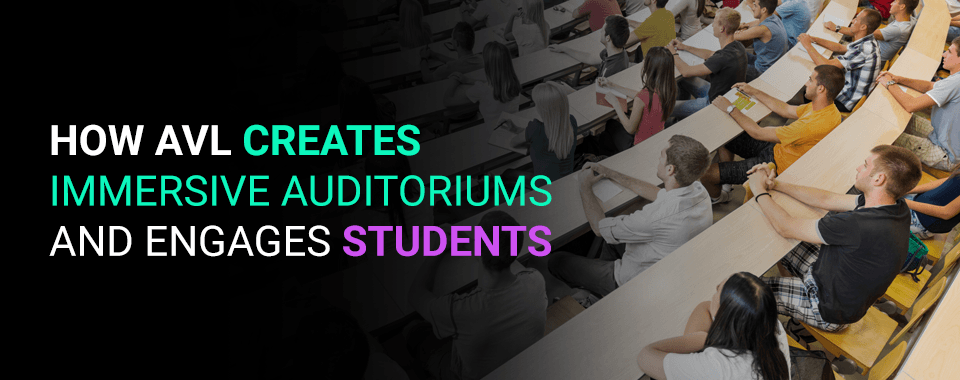
A school auditorium is a versatile space that meets the needs of students, professionals and the greater community. From theatrical plays, graduations and assemblies to concerts, seminars and special lectures, a number of events rely on auditoriums to set the stage across school campuses large and small. As a platform that showcases diverse ideas, entertainment and information, a designated space to feature these guests is not enough. For knowledge to be effectively transferred and retained, audiences within the auditorium must be fully engaged in the presentation.
The most important goal of any presentation or performance is to successfully engage the audience. Ideally, each audience member will be focused on the presenter as if they were engaged in a direct conversation with those on stage. Unfortunately, even the most exciting, interesting and evoking topics can fail to capture the full attention of an audience if the auditorium lacks the vital equipment needed to facilitate viewer engagement. Without an effective AVL system, your auditorium may not cater to the engagement needs of your audience.
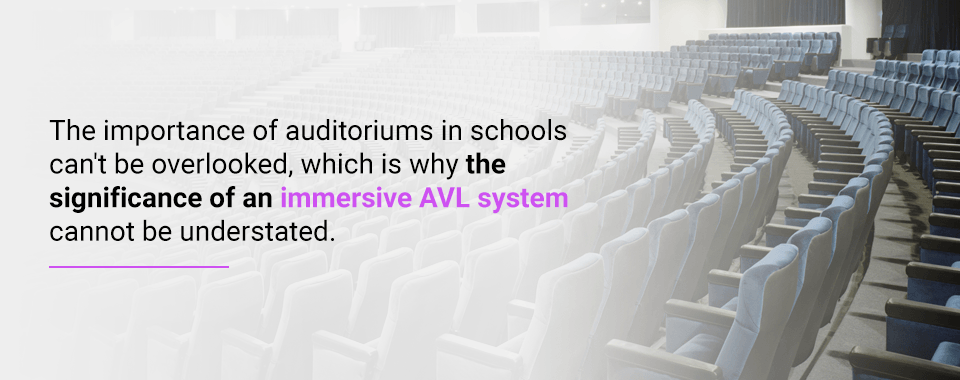
Dynamic AVL systems can work wonders in your auditorium. These advanced builds are uniquely designed to enhance the wide spectrum of events that take place within your assembly space. The importance of auditoriums in schools can’t be overlooked, which is why the significance of an immersive AVL system cannot be understated. Thankfully, creating an immersive and engaging experience for auditorium audiences is possible with help from the AVL specialists at Illuminated Integration. Our team of experts can outfit your auditorium with the resources needed to keep students endlessly engaged.
Visual elements play a key role in the transfer of ideas and information. In fact, over half of the population are considered visual learners. With such a large percentage relying on visual aids, it’s no wonder that so many presentations use these tools in academic contexts. Visual aids help keep the audience engaged by highlighting the key concepts the audience should retain. They can also assist in overcoming some language barriers that members of the audience — such as exchange, transfer or ESOL students — may have.
Popular methods of visual communication aid include projections, digital presentations and film screenings. Presenters may also choose to write manually on whiteboards, utilize flip charts, hand out documents or even use props during their discussion. Electronic visual aids will require a reliable video or projection system that provides clear picture resolution. Physical visual aids will require adequate lighting to ensure that they’re clearly visible to all members of the audience throughout the auditorium. A versatile AVL system can be equipped to showcase all visual aids.
The auditorium’s stage is often used for theatrical productions as well. Regardless of whether the playbill depicts a wildly imaginative musical or an intimate solo performance, the lighting used both on-stage and throughout the auditorium can significantly impact the experience that members of the audience have. One of the most powerful elements of stage design, theatrical lighting illuminates the actors and set pieces to provide audience members with a clear view of the stage. Versatile lighting systems can also:
Dynamic lighting provides the clarity and composure that theatrical plays, concerts and other products need to be as engaging as possible. However, there’s another aspect of the live experience within the auditorium that also requires appropriate lighting — the house seating. Adequate lighting is needed above and around the seating area and aisles. This lighting system needs to be versatile enough to adjust to any condition. For example, it must be able to provide clear visibility for safe movement, routine cleaning, document reading and personal computer viewing.
Knowing how to design a good auditorium isn’t enough to ensure that students, visitors and guests will remain engaged with the events on the stage. A versatile AVL system can be integrated throughout the auditorium to provide the optimal lighting conditions for the stage, seating area and aisles. With the ability to illuminate any space with the desired brightness, the lighting system can be paired with a video system to deliver crisp, clear visuals that the audience can easily interpret.
Exceptional lighting and visual performance from your AVL system are absolutely necessary, but they aren’t the only aspects of an AVL system that must perform optimally. The success of nearly every event in your auditorium also relies on the seamless coordination of the AVL system’s audio features. Quality audio performance can enrich audience engagement, immersing students, faculty and guests in a complete sensory experience.
The human voice is a powerful instrument, and our ability to notice changes in vocal inflection on an acute level is astounding. Our sense of hearing is exponentially more sensitive than our sense of sight, so much so that our ears can distinguish more than a thousand different changes in tone. Level of pitch, speed of speech and adjustments in volume are all critical components of communication. In fact, research suggests that how something is said has a much more profound impact than what exactly was said.
Unfortunately, this inflection can be mitigated, muddled or lost due to poor audio quality. No matter the size of your auditorium, you should not expect that all audience members can hear the sounds emanating from the stage at the appropriate level. Though you must keep in mind that members of the audience may have hearing problems, you should also remember that too much amplification can also hinder audience enjoyment. Low-quality audio equipment can cause sounds to spike, crackle, muffle or be completely unintelligible.
Aside from the system itself, the acoustics of your auditorium play a significant role in an AVL system’s success. To deliver a truly immersive audio experience, the auditorium’s acoustical design must cater to the unique events that take place. The room should be designed in a way that properly diffuses sound, limits reverberation time and eliminates defects while also ensuring that interior and exterior sound does not penetrate through the auditorium walls.
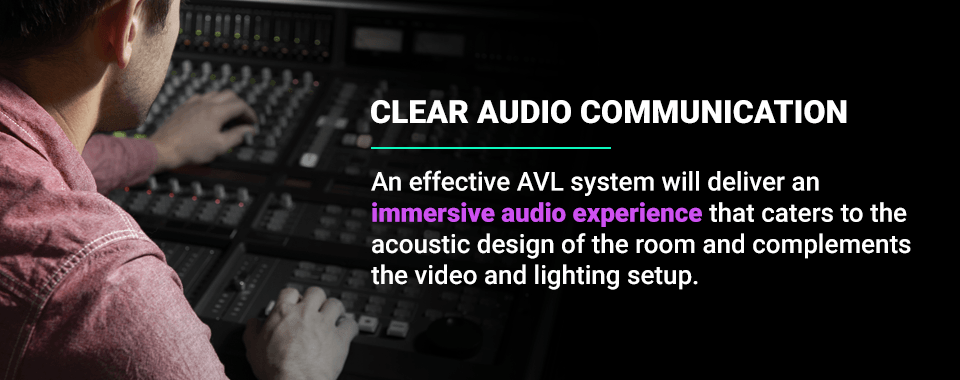
Though visual points of focus may succeed in grabbing students’ attention, these audience members may lose focus if the accompanying audio is not up to par. An effective AVL system will deliver an immersive audio experience that caters to the acoustic design of the room and complements the video and lighting setup. Clear audio communication is essential for all auditoriums to maintain student engagement.
Research has highlighted three specific components that direct student engagement. During assemblies in an auditorium, a student will ideally stay focused and attentive to the events on stage. However, disruptions can prevent this engagement on a behavioral, emotional or cognitive level. Disruptions occurring inside and outside of the auditorium can interrupt an event and immediately disengage the focus of those in attendance. Because student engagement enhances the learning experience, it’s critical that these disruptions are kept to a minimum.
Disruptions in the presentation — even those which are intermittent or momentary — can create lasting negative impacts. First and foremost, they can cause the audience to lose focus. Without a sustained focus, either party may consider the presentation a failure or see it as lacking in efficiency. A lapse in focus can also disrupt the psychological state of the audience or performer, causing them to lose confidence or interest in the presentation. This situation can then lead to a perceived loss of credibility, potentially impacting future presentations or performances.
Inadequate AVL systems or failures in these systems can instantly disengage students. Audio or video outages, inefficient lighting applications and poor auditorium acoustics can cause an audience member to lose focus and devote their attention elsewhere. A lack of engagement by some audience members may further contribute to the disruption of focus in other audience members. This domino effect can then distract or interrupt those on stage, which increases the chances of more audience members becoming disengaged.
Though you can’t control every variable that can contribute to the interruption of an event, you can proactively protect the integrity of your auditorium’s audio, video and lighting executions by integrating a reliable AVL system that reduces or eliminates disruptions. Appropriate lighting techniques, clear audio transmission and easy-to-interpret visuals can minimize and remove potential disruptions, allowing your auditorium AVL system to succeed in creating an engaging connection between students and the stage.
Easy-to-interpret visuals, clear audio communication and a lack of internal or external disruptions are three keystones that construct a channel for communication between those on the stage and those in the audience. This connection is vital to the effectiveness of live events — if a performance is not immersive or engaging enough to sustain audience attention, the transfer of ideas, knowledge and entertainment will fail. AVL systems can be designed to enhance the three primary types of communication: verbal, nonverbal and visual.

Of the many events that take center stage in your auditorium, verbal communication is likely a critical element in every presentation and performance. Whether your event features musicians, speakers or prerecorded sound, the successful delivery of this audio is dependent upon the AVL system’s ability to provide crisp, clear sound throughout the venue. Systems that can’t accomplish this goal may cause audience members seated in the rear of the auditorium, or those with hearing impairments, to become disengaged with the event.
While verbal communication is an effective way to deliver information, nonverbal communication is another powerful tool that can convey tone, subtext and ideas. Types of nonverbal communication include gestures, vocal tone, facial expressions, body movements and posture. Even color, lighting and other physical elements on stage can facilitate and impact how students interpret nonverbal communication. Having an AVL system in your auditorium that enhances nonverbal communication can improve a student’s ability to become meaningfully engaged in the presentation, lecture or performance.
Visual communication is similar to nonverbal communication in that it reinforces verbal communication, but its method of delivery is different. Some examples of visual communication on a stage are videos, projections, signs and whiteboards. In some contexts, such as lectures and presentations, these visual aids may be delivered in the form of paper documents. Regardless of whether the focus is on the stage or on a handheld printout, the auditorium requires an AVL system that features video and lighting capable of providing audiences with clear visibility throughout the room.
When the connection between the stage and the audience is broken, communication is lost. Similar to the way disruptions cause a loss of audience focus, the level of engagement can also be diminished when these two parties fail to establish and sustain a bond. Maintaining this connection is especially important in an educational context because students may have a learning style that’s dependent on visual aids, auditory enhancements or the ability to engage in a more tactile or cognitively challenging manner.
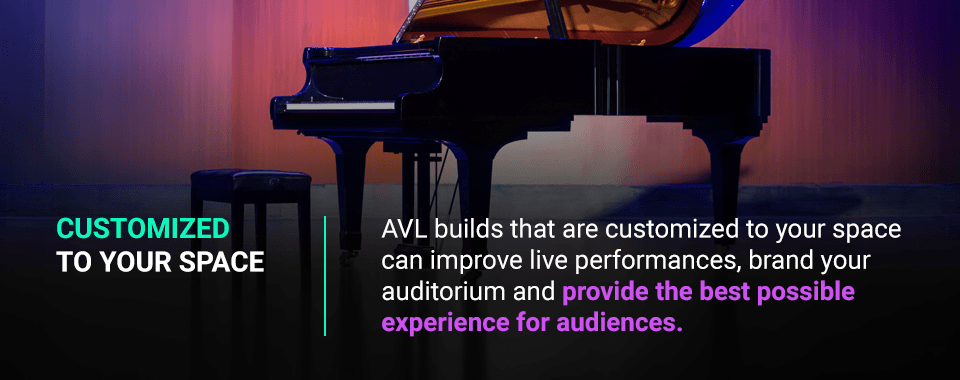
A dynamic AVL system can drastically improve the live experience, but the equipment alone can’t accomplish this goal. The key to optimizing the potential of an AVL system is to appropriately integrate it into the desired space. Knowing how to design a good auditorium AVL build is just as important as knowing which audio, video and lighting components are needed to achieve the best results. AVL builds that are customized to your space can improve live performances, brand your auditorium and provide the best possible experience for audiences.
Imagine constructing a set piece for a stage play that’s much larger than the stage itself. Now, imagine constructing the same set piece in a much smaller size that’s hardly visible from the back of the house. In both scenarios, neither set piece is appropriately sized to be functional in your specific auditorium space. AVL systems are similar — too large of a build can be excessive while too minimal of an AVL design cannot accommodate the needs of the space.
When you customize your AVL build to the exact dimensions of your auditorium, you ensure that every event taking place on stage has the optimal audio configurations, video capabilities and lighting setup. All amplification will reach the back of the theater without sounding overbearing. In addition, all spaces from the stage to the last row of seats will be appropriately illuminated, and all visual elements projected or played through video will be clearly visible. When AVL systems are fitted to auditoriums properly, they’re able to function optimally.
AVL systems are great resources that enrich the live experience, but did you know they can also be used to simultaneously reinforce your school’s brand? Consider the AVL systems that power other areas of your campus. Do you use exterior track lights to guide students to each building? Do you showcase special facilities like gymnasiums or sports fields with lights that match your school colors? You can easily incorporate these same designs within the auditorium to keep your branding consistent throughout campus.
Ultimately, your auditorium AVL system should be a turnkey solution that delivers a seamless experience. The installation of this system should be fully customized with an original design that meets the needs of your space, improves performances and upholds your unique branding. As you consider your AVL build, create a detailing of the previous and future events your auditorium may host, including:
Does your auditorium need a customized AVL build to support a variety of diverse needs? Let the experts at Illuminated Integration help you figure out how to design a good auditorium AVL integration that keeps your audience engaged.
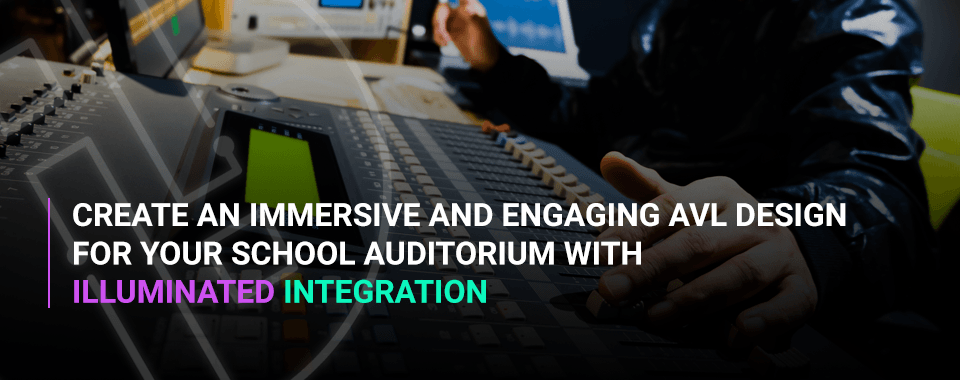
AVL systems can dramatically enhance all events that take place within your auditorium. With the ability to offer an immersive auditory and visual experience, integrating these systems into your facility will help you engage the students and guests that attend presentations and performances on campus. For help designing your new AVL setup, trust the knowledgeable team at Illuminated Integration. We’re ready to help you incorporate the perfect AVL build into your school’s auditorium. If you have questions about your auditorium’s AVL setup, feel free to contact us today.